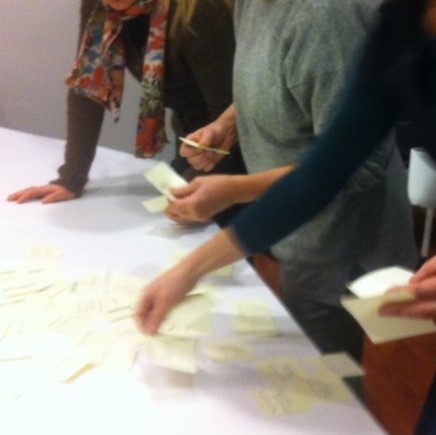The research group Embodied Making and Learning at the University of South-Eastern Norway
DOI:
https://doi.org/10.7577/formakademisk.5186Emneord (Nøkkelord):
EMALSammendrag
There is no one history of the research group Embodied Making and Learning (EMAL). EMAL is an interdisciplinary research group that addresses the phenomenon of embodied making and learning. We work together to achieve three main aims: to enhance quality in our research, to further community and cooperation between researchers, and to contribute to developing our field nationally and internationally.
Referanser
AECEA, P. E. (2009). Arts and cultural education at school in Europe. Education, Audiovisual and Culture Executive Agency. http://eacea.ec.europa.eu/education/eurydice/documents/thematic_reports/113EN.pdf
Bamford, A. (2006). The wow factor: Global research compendium on the impact of the arts in education. Waxmann.
Bamford, A. (2012). Arts and cultural education in Norway 2010-2011. http://www.kunstkultursenteret.no/sites/k/kunstkultursenteret.no/files/1f0ba571783fe8dc31a13ac76d5f196a.pdf
Bammer, G. (2013). Disciplining interdisciplinarity. Integration and implementation sciences for reseaching complex real-world problems. Australian National University E-press. https://doi.org/10.26530/OAPEN_459901
Bruner, J. S. (1960). The process of education. Harvard University Press.
Dunin-Woyseth, H., & Michl, J. (2001). Towards a disciplinary identity of the making professions: The Oslo millennium reader. Oslo School of Architecture.
EMAL HiT. (2015a). Deltakergrupper innenfor Forskergruppen EMAL September 26 2015.
EMAL HiT. (2015b). Embodied making and learning research group. Høgskolen i Sørøst-Norge.
EUC. (2007). Conclusion of the Council and of the Representatives of the Governments of the Member States, meeting within the Council of 15 November 2007, on improving the quality of teacher education. Council of the European Union. http://eur-lex.europa.eu/LexUriServ/LexUriServ.do?uri=OJ:C:2007:300:0006:0009:EN:PDF
European Commission. (2013). Education and training in Europe 2020: Responses from the EU member states. Eurydice.
Forvaltningsdatabasen. (u.å). Statens lærerskole i forming, Notodden - Endringshistorie. Norsk Samfunnsvitenskapelige Datatjeneste, NSD. https://www.nsd.no/polsys/data/forvaltning/enhet/21660/endringshistorie
Gibbons, M., Limogens, C., Schwartzmann, S., Scott, P., & Trow, M. (1994). The new production of knowledge: The dynamics of science and research in contemporary societies. Sage.
Gibbons, M., & Scott, P. (2001). Re-thinking science. Knowledge and the public in an age of uncertainty. Polity Press.
Gulliksen, M. S. (2003). Finnes det en teoretisk drøftingstradisjon innen mitt fagfelt? In J. Sandven (Ed.), Fagkultur og kernefaglighed. Dokumentasjon fra NordFo-symposium Fredriksberg Seminarium 2.-6. oktober 2002 (B:12 ed., Vol. 2003, pp. 160–179). NordFo.
Gulliksen, M. S. (2014). Beredskapskunnskap - navet i lærerutdanning i Kunst og håndverk. FORMakademisk, 7(5), 1–19. https://doi.org/10.7577/formakademisk.902
Gulliksen, M. S., & Hjardemaal, F. R. (2016). Choosing content and methods: Focus group interviews with faculty teachers in Norwegian pre-service subject teacher education in design, art and crafts. Scandinavian Journal of Educational Research, online first, 3. November, 2014(1/2016). https://doi.org/10.1080/00313831.2014.967809
Gulliksen, M. S., & Homlong, S. (2013). Editorial, making, materiality, and knowledge. FORMakademisk, 6(2). https://doi.org/10.7577/formakademisk.649
Høgskolen i Telemark. (2013). FOU-SAK 33-13 Tiltak for å øke eksterne inntekter.
KEA European Affairs. (2009). The impact of culture on creativity. European Commission (Directorate-General for Education and Culture). https://keanet.eu/wp-content/uploads/2019/09/impactculturecreativityfull.pdf
Kjosavik, S. (1998). Fra ferdighetsfag til forming : utviklingen fra tegning, sløyd og håndarbeid til forming sett i et læreplanhistorisk perspektiv [From a skill subject to Forming]. [Dr. thesis, Det utdanningsvitenskapelige fakultet, Universitetet i Oslo]. https://www.nb.no/search?q=oaiid:%22oai:nb.bibsys.no:999900829544702202%22&mediatype=b%C3%B8ker
Litt, T. (1949). Führen oder Wachsenlassen. Eine Erörterung des Pädagogischen Grundproblemes. Verlag von Ernst Klett.
Meld. St. 18 (2014-2015). Konsentrasjon for kvalitet — Strukturreform i universitets- og høyskolesektore. https://www.regjeringen.no/no/dokumenter/meld.-st.-18-2014-2015/id2402377/
NOKUT. (2015). Akkreditering som universitet — Veiledning for institusjoner som søker akkreditering som universitet. NOKUT.
Nyzell, S. (forthcoming). Grendels Skatt - Återskapad tidig medeltid och gränslanden mellan historia, sanning och fiktion.
Research Council of Norway. (2018a). Evaluation of Norwegian education research. Report from the International Expert Committee Final Report 22 February 2018. https://www.forskningsradet.no/om-forskningsradet/publikasjoner/2018/evaluation-of-norwegian-education-research/
Research Council of Norway. (2018b). Institutional feedback from the evaluation committee - University College of Southeast Norway, HSN.
Winner, E., Goldstein, T. R., & Vincent-Lancrin, S. (2013). Art for art's sake? The impact of arts education. OECD - Centre for Educational Research and Innovation. https://doi.org/10.1787/9789264180789-en

Nedlastinger
Publisert
Hvordan referere
Utgave
Seksjon
Lisens
Opphavsrett 2023 Marte S. Gulliksen

Dette verket er lisensiert under Creative Commons Attribution-NoDerivatives 4.0 International License.
- Forfatteren(e) beholder sin opphavs- og kopieringsrett til eget manuskript, men gir tidsskriftet varig rett til 1) å fremføre manuskriptet for offentligheten i den opprinnelig publiserte digitale form, og 2) å registreres og siteres som første publisering av manuskriptet.
- Forfatteren må selv forvalte sine økonomiske kopieringsrettigheter overfor eventuell tredjepart.
- Tidsskriftet gir ingen økonomisk eller annen kompensasjon for innsendte bidrag, medmindre det er gjort særskilt avtale om dette med forfatteren(e).
- Tidsskriftet plikter å arkivere manuskriptet (inklusive metadata) i den opprinnelig publiserte digitale form, i minst ett dertil egnet åpent tilgjengelig langtidsarkiv for digitalt materiell, som for eksempel i de norske universitetenes institusjonsarkiv innen rammen av NORA-samarbeidet.
Verket vil bli publisert OpenAccess med en Creative Commons 4.0-lisens som tillater alle å lese, dele og tilpasse innholdet, også kommersielt, under lisensvilkårene:
Dette verket må tilskrives/ krediteres på riktig måte, en lenke må gis til CC-BY 4.0-lisensen, og endringer som er gjort må angis på en rimelig måte, men ikke på noen måte som antyder at lisensgiveren støtter deg eller din bruk.



